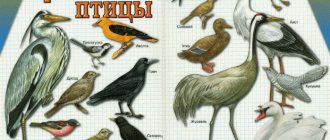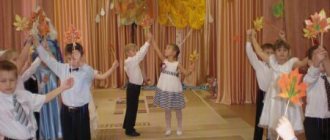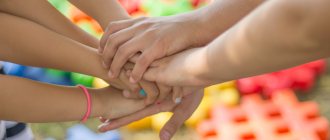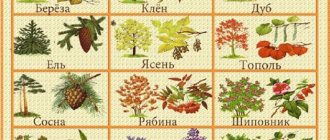Summary of a logorhythmic lesson with children with stuttering in the older group
Bibliographic description:
Efremova, A. V. Abstract of a logorhythmic lesson with children with stuttering in the senior group / A. V. Efremova, A. E. Petrova. — Text: direct // Questions of preschool pedagogy. — 2021. — No. 8 (25). — P. 66-68. — URL: https://moluch.ru/th/1/archive/140/4462/ (access date: 11/19/2021).
Topic : Toys
Form: group.
Equipment: toys, a basket, a ball, a doll, rugs and chairs according to the number of children , equipment for playing music and musical material (“Sweet Dream”, “March of the Tin Soldiers” by P. Tchaikovsky, “Oh, the hoop broke”, Ukrainian folklore). chalk, sample T. Popatenko)
Goal : clarification of acquired knowledge.
Objectives : educational: clarify and consolidate vocabulary on a lexical topic; correctional: learning to relax and tense muscles, reducing muscle tension, practicing whispering speech; developing: development of general motor skills and spatial orientation, development of a sense of rhythm, the ability to convey musical rhythm, develop perception of music, development of physiological breathing; educational: to cultivate attention to the teacher’s speech, the ability to work in a team.
Content:
1. Relaxation “The dolls woke up.”
Speech therapist: We are going to the land of toys, but in order to find ourselves there you need to plunge into a magical dream. Children lie down on rugs, calm music sounds (“Sweet Dream” by P. Tchaikovsky)
Speech therapist: “In the morning the doll woke up, arms up and stretched, washed, got dressed, combed her hair neatly.” Children depict actions.
2. Exercise to regulate muscle tone. "Rag Doll - Tin Soldiers"
We have a doll Masha,
Our rag doll
The doll is soft like cotton wool
There is not enough hardness in it. — Children relax by pretending to be a doll.
But we have soldiers
Solid, straight pewter. - Children tense up, straighten their backs, press their arms to their body, keep their legs together.
The exercise is repeated several times.
(Smirnova L.N. Speech therapy for stuttering. Classes with children 5–7 years old in kindergarten. A manual for speech therapists, educators and parents. - M.: Mozaika-Sintez, 2006. - 64 p. - p. 7)
3. Exercise to develop a sense of rhythm and orientation in space. To the music of P. I. Tchaikovsky “March of the Tin Soldiers”.
| Here are the soldiers standing |
| the parade begins. |
| One two three four five |
| We begin to walk. |
Children learn the exercise as the teacher demonstrates:
1 bar.
| 2 bars
|
3 beat.
|
4. Breathing exercises
"Ball"
Parsley brought an inflatable ball. We'll inflate him.
Children stand in a close circle, holding hands; take a deep breath, step back and stop, and as you exhale, squeeze the circle.
"Caught the ball"
Feet shoulder-width apart, raise your arms up - inhale; As you exhale, press your hands to your chest and say “Ha!” Repeat 3-4 times
5. Counting book “We play with toys”
1) The speech therapist reads a quatrain. Children repeat it after the adult and clap their hands in time with the poem (four claps for each line).
We play with toys
We call toys:
Drum, spinning top, accordion,
Robot, doll, matryoshka.
(Smirnova L.N. Speech therapy for stuttering. Classes with children 5–7 years old in kindergarten. A manual for speech therapists, educators and parents. - M.: Mozaika-Sintez, 2006. - 64 p. - p. 7)
2) Children stand in a circle, pass the ball around and recite the poem.
6. Musical game “The doll is dancing”
Musical accompaniment
Part 1 “Sweet Dream” (fragment), music. P. Tchaikovsky
Part 2 “Oh, the hoop burst”, Ukrainian. adv. chalk, arr. T. Popatenko
Equipment: toy - doll
Description of the exercise.
Children sit on chairs in a semicircle in front of the teacher. To music playing at a slow tempo (part 1), the doll, led by adults, dances, and children slowly clap their hands to the music. When the music and dance ends, the children place their hands on their knees. The doll dances again, but to fast music (part 2), and the children accompany the dance by clapping at a fast pace. When the music and dance ends, the children place their hands on their knees.
“Listen to the music the doll will dance to. The music will be either slow or fast. When the doll dances, you clap your hands to the beat of the music. If the music is fast, then you clap your hands just as quickly, and if the music is slow, then you clap your hands less often. When the music and dance are over, place your hands on your knees.
The game is played several times, then played without a visual reference. (Yu. O. Filatova N. N. Goncharova E. V. Prokopenko Logorhythmics: Technology of development of motor and speech rhythms in children with speech disorders: Educational manual / edited by L. I. Belyakova. - M.: National Book Center , 2017–208 pp. (Speech therapy technologies.), p. 26).
7. Practicing whispered speech. "Putting away the toys"
Speech therapist: “The toys are tired and have fallen asleep, they need to be put in the basket, but you need to speak quietly so that they don’t wake up.” Children take turns coming up, taking a toy and putting it in the basket, commenting on their actions. I put Parsley in the basket, and a reel in the drawer.
I put a matryoshka doll in the basket.
I put the tumbler in the basket. I put the ball in the basket.
I put the car in the cart. Etc.
(Smirnova L.N. Speech therapy for stuttering. Classes with children 5–7 years old in kindergarten. A manual for speech therapists, educators and parents. - M.: Mozaika-Sintez, 2006. - 64 pp. - p. 6.)
8. Relaxation.
Children lie down on rugs, calm music sounds (“Sweet Dream” by P. Tchaikovsky). The game ends with the words: “They put the doll to bed. Well, it’s time for us to get up!”
Key terms
(automatically generated)
: child, hand, doll, Tchaikovsky, kindergarten, music, ending of music, Sweet dream, calm music, whispered speech.
Musical and logorhythmic classes for children with stuttering studying in speech therapy groups
Shashkina Gulnara Rustemovna,
Candidate of Pedagogical Sciences, Associate Professor of the Department of Speech Therapy
Faculty of Special Pedagogy
GBOU VPO MGPU
Musical and logorhythmic classes for children with stuttering studying in speech therapy groups
Music classes in kindergarten for children with speech disorders are closely related to the activities of the speech therapist; speech material is a kind of addition to his work on speech correction. The basis of this activity is the rhythm of J. Dalcroze, based on the principle of interest and accessibility.
There are some specific features or requirements for conducting music classes with children with speech impairments. These requirements are outlined in the manual for music directors by Boromykova O. S. “Correction of Speech and Movement” (“Childhood - Press”, St. Petersburg, 1999) and the book “Methodology of Musical Education for Children with Developmental Problems and Corrective Rhythmics” edited . Nazarova N. M.
Classes are conducted taking into account the individual capabilities of children, since it is not always possible to use the music education program in full. Often the requirements are underestimated: children of the older group are taught according to the material of the middle group.
Classes are structured taking into account children's speech disorders. So, for children with ODD, classes are structured especially emotionally, with a quick change of activities so that they do not get tired. The same topic is repeated 2-4 times until it is mastered. Particular attention is paid to singing vowel sounds, since it is vowels that give our speech clarity and intelligibility.
During music classes with children with physical disabilities, a lot of work is done to develop auditory and visual perception and improve motor skills.
For children who stutter, the main goal is to develop tempo and rhythm of movement and speech, fluency and coordination.
In music classes, speech, music and movement are closely interrelated. As a result, the teacher achieves not only purity of intonation, but also expressiveness in singing.
The main principle in the work is the principle “from simple to complex”. First you need to teach your child the basic types of movements to music. These are various types of walking, running, jumping, exercises with tasks for all types of muscles, dancing, round dances, games with singing. At the same time, speech material is necessarily introduced in a wide variety of forms - lyrics, round dances, dramatization with singing, staging.
Musical and rhythmic games with singing allow you to train various muscle groups and develop coordination of movements. Musical accompaniment affects the quality of performance: it improves the plasticity of movements, gives them softness and expressiveness. Creating a certain image develops children's imagination and auditory attention. The speech therapy task is to develop the tempo and rhythm of movements, the exact combination of speech and movement, and the consolidation of vowel sounds in free speech. The musical task is to perform movements to the rhythm of the music.
Example exercise. “Sawmillers”, music. Boromykova O. S.
The saw started cutting and buzzed like a bee.
I sawed off a piece, ran into a twig,
She burst and stood up. Start over.
Description of movements. I. p. - children stand in pairs, facing each other. Hands are kept crossed. One leg is put forward, the other back.
1-8 bars - move your hands forward and back, imitating sawing wood.
9 - 10 measures - Lower the arms downwards.
11 - 12 measures - change places with each other while running.
When listening to music, it is recommended to use prose and poetry. Speech material will help the child understand the content of a piece of music. Vivid and expressive poetic images allow you to express emotions in actions.
For example, “An Old French Song” by P. I. Tchaikovsky (“Children’s Album”) is listened to while reading a poem about a princess, “Italian Song” is listened to with a poem about Italy, song and guitar, “Nanny’s Tale” is listened to while reading a night story.
The work of the music director in the “Singing” section is divided into several stages. The first stage is singing the vowels. Particular attention is paid to breathing during singing, voice production, tempo and rhythm of speech. The task of this stage is to develop the muscles of the speech apparatus and distinguish vowels by ear.
The second stage is pure speech with singing to consolidate whistling and hissing sounds, the third - to consolidate sonorant sounds, the fourth - to consolidate all sounds in free speech.
Singing work is not limited to purely sound work. It should differ in such an important aspect as the development of the child’s emotional sphere. To achieve a positive effect, songs of different characters are selected so that children can feel the difference in mood and express it with their movements.
For example, the song “Perch” with the sound O, “Antoshka” - A, “Donkey” - I, “Hoopoe” - U, “White Hare” - L, “Rubber Zina” - Z, “Mishutka” - Sh, etc. P.
Dramatizations and games with singing contribute to the development of coordination of speech with movement, form the ability to move in space and in a group, develop emotional expressiveness of movements and speech, creativity and imagination.
An example is the performances presented by Boromykova O.S. with a description of speech therapy and musical tasks, movement performance and musical application, such as “Little Goat”, “The Goat and the Shepherd”, “Here comes the Fox”, “Kolobok”.
Thus, the specifics of the music director’s work depend on the severity of the children’s speech impairment, on the level of development of the motor sphere and on the stage of speech therapy work in the group.
Logorhythmic classes for children with stuttering take into account the characteristics of their speech and motor functions.
Children with stuttering have pronounced motor disturbances: tension in muscle tone before the start of speech, incoordination of movements, including speech, the presence of motor tricks, disturbances in the tempo and rhythm of movements.
According to the level of development of the motor sphere, all children with stuttering can be divided into two subgroups: with a low level, which includes children with neurosis-like stuttering, and with an average level, where children with neurotic stuttering predominate. The unique nature of motor disorders requires the logorhythmist to use differentiated methods of influence.
The main task of speech therapy rhythm for people who stutter is to normalize the tempo and rhythm of movements and speech, teach muscle relaxation, and develop coordination motor skills. Normalization of the motor sphere promotes a critical attitude towards one’s own movements and speech, fosters a sense of self-confidence, relieves emotional and stressful tension in communication, and builds resistance to difficult emotional situations.
Logorhythmic classes with stutterers are carried out from a very early age, from 2 to 3 years old, and are an integral part of any correctional method for eliminating stuttering.
The content of logorhythmic work depends on the stage of speech therapy work; there is a close relationship between the group speech therapist and the logorhythmist.
In the conditions of the speech therapy group of a compensatory kindergarten, the formation of fluency in the speech of children with stuttering is carried out in stages, from simple to complex: the stage of speech restriction, conjugate reflected speech, dialogic speech, independent speech and the stage of spontaneous emotional communication. Each stage has its own tasks and speech therapy technologies for the formation of smooth speech, and the means of speech therapy rhythms are also differentiated.
Means of speech therapy rhythms at the stages of fluent speech formation.
Period of speech restriction.
The task of speech therapy work is to limit the speech communication of children in order to gradually abandon their previous speech and break the old speech stereotype. During logorhythmic classes during this period, all non-speech means are introduced, such as exercises for various types of walking and running, exercises for the development of breathing, exercises for the development of muscle tone, exercises for the development of voluntary attention, motor memory, fine and facial motor skills.
The exercises are alternated by listening to musical excerpts - instrumental or vocal music. The themes of musical works are correlated with the themes of speech therapy classes.
Stage of conjugate and reflected speech.
In speech therapy classes, speech breathing develops and improves, the phrase gradually increases to 4 - 5 words pronounced in one exhalation, basic speech rules are formed, and articulatory motor skills develop.
In logorhythmic classes, in addition to non-speech means, low-load speech means are gradually introduced, such as exercises and games with singing, exercises for developing breathing with speech accompaniment, exercises for developing diction and articulation, exercises for developing fine motor skills with speech accompaniment.
Dialogue speech stage.
Speech therapy work is aimed at the ability to slowly, clearly and clearly answer a question, selecting individual words according to their meaning, before starting speech, take a breath and pronounce the answer as you exhale, smoothly, emotionally and expressively.
The development of the prosodic side of speech continues to take shape in logorhythmic classes. During this period, the following tools are offered: exercises for voice development, exercises for coordination of movements and speech, games with speech accompaniment, counting exercises, songs, dialogues with musical accompaniment.
Stage of independent speech.
Speech therapy classes develop the ability to retell the stories of a speech therapist, and then independently tell a series of plot pictures, a plot picture and a plan. Logorhythmic classes include as much as possible speech tasks, games and exercises without musical accompaniment, exercises with dance elements, exercises with objects and speech accompaniment.
The stage of spontaneous emotional speech consolidates the skills of smooth speech in a specific communication situation. Logorhythmic activities include creative tasks with elements of theatrical activity, musical and motor games, dramatizations and melodic recitation - reading poetic texts to musical accompaniment.
Thus, by the stage of spontaneous emotional speech in children with stuttering, basic motor qualities are formed in all types of motor skills, and the skill of fluent speech is improved on material of any speech complexity.
Literature.
1. Volkova G.A. Speech therapy rhythmics - M., Education, 1985.
3. Griner V.A. Speech therapy rhythms for preschoolers: A manual for workers in speech therapy institutions. 2nd ed., M., Uchpedgiz, 1958. (illustration, notes).
4. Rau E.F. Musical and rhythmic classes. — In the book: 5th scientific session on defectology. M., 1967.
5. Rychkova N.A. Techniques for examining motor skills in preschool children who stutter. - J. “Defectology” No. 3, 1984, p. 69-74
6. Rychkova N.A. Speech therapy rhythm in the system of correctional work to overcome stuttering in preschool children. - Defectology, 1987, N 3, pp. 60-64.
7. Samoilenko N.S., Griner V.A. Speech therapy rhythm for preschoolers. - M., 1951.
8. Shashkina G. R. Speech therapy rhythm for preschoolers. Textbook - M., 2002.
Pfingers move slowly and chaotically; “All four petals” - the fingers of the same name are alternately connected; “I wanted to rip it off” - bending and straightening of the fists; “He took wing and flew away” - flapping his hands).
Exercises with objects develop static and dynamic coordination of movements, target accuracy and plasticity of movements and are challenging for young children. Movements can be performed to music or poetic text. The speech therapist pronounces the speech material and shows the movements to it, learning exercises is carried out along with the speech at a slow pace in parts, then the pace increases. You can use different objects - sticks, ribbons, hoops, balls, handkerchiefs. (For example, the exercise “Pass the handkerchief”. Children stand in a circle. One of them has a handkerchief in their hands. To the strong beat of music at 2/4, you need to pass the handkerchief in a circle, turning to face the neighbor).
Exercises for the development of the emotional and volitional sphere develop expressiveness and coordination of movements, emotionality, a sense of beauty, facial motor skills, and are performed to music. For example, the exercise “Butterflies in the meadow”, music. accompaniment "Waltz of the Flowers". (The first part of the musical accompaniment - to a light dance melody (waltz), children depict the flight of butterflies in a circle or scattered. When the music ends, the children stop, the speech therapist chooses the most beautiful butterfly, it becomes the leader. The second part of the music - all children perform the movements of this butterfly.
The exercises used in logorhythmic classes for young children are aimed at regulating muscle tone, static and dynamic coordination of movements, fine motor skills, switchability of movements, sense of rhythm, developing phonation breathing, enriching and activating vocabulary, and developing speech understanding.
Literature.
- Badalyan L. O. Scheme of normal psychomotor development of children. Neuropathology. M., "Academy" 2001.
- Kozyrevoy L. M. Indicators of speech development in children of the third year of life. Child speech development. Children from birth to 5 years old, Yaroslavl, Development Academy, 2001.




